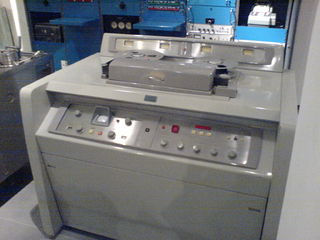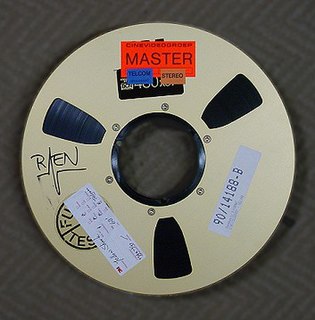Related Research Articles

The Compact Cassette or Musicassette (MC), also commonly called the tape cassette, cassette tape, audio cassette, or simply tape or cassette, is an analog magnetic tape recording format for audio recording and playback. It was developed by the Dutch company Philips in Hasselt, Belgium, by Lou Ottens and his team. It was introduced at the Berlin Radio Show on August 30, 1963. Compact Cassettes come in two forms, either already containing content as a prerecorded cassette (Musicassette), or as a fully recordable "blank" cassette. Both forms have two sides and are reversible by the user.

An audio tape recorder, also known as a tape deck, tape player or tape machine or simply a tape recorder, is a sound recording and reproduction device that records and plays back sounds usually using magnetic tape for storage. In its present-day form, it records a fluctuating signal by moving the tape across a tape head that polarizes the magnetic domains in the tape in proportion to the audio signal. Tape-recording devices include the reel-to-reel tape deck and the cassette deck, which uses a cassette for storage.
A cassette deck is a type of tape machine for playing and recording audio cassettes that does not have a built-in power amplifier or speakers, and serves primarily as a transport. It can be a part of an automotive entertainment system, a part of a portable mini system or a part of a home component system. In the latter case it is also called a component cassette deck or just a component deck.

Nagra is a brand of portable audio recorders produced from 1951 in Switzerland. Beginning in 1997 a range of high-end equipment aimed at the audiophile community was introduced, and Nagra expanded the company’s product lines into new markets.

Ampex is an American electronics company founded in 1944 by Alexander M. Poniatoff as a spin-off of Dalmo-Victor. The name AMPEX is a portmanteau, created by its founder, which stands for Alexander M. Poniatoff Excellence. Today, Ampex operates as Ampex Data Systems Corporation, a subsidiary of Delta Information Systems, and consists of two business units. The Silicon Valley unit, known internally as Ampex Data Systems (ADS), manufactures digital data storage systems capable of functioning in harsh environments. The Colorado Springs, Colorado unit, referred to as Ampex Intelligent Systems (AIS), serves as a laboratory and hub for the company's line of industrial control systems, cyber security products and services and its artificial intelligence/machine learning technology.
Flanging is an audio effect produced by mixing two identical signals together, one signal delayed by a small and gradually changing period, usually smaller than 20 milliseconds. This produces a swept comb filter effect: peaks and notches are produced in the resulting frequency spectrum, related to each other in a linear harmonic series. Varying the time delay causes these to sweep up and down the frequency spectrum. A flanger is an effects unit that creates this effect.

Reel-to-reel audio tape recording, also called open-reel recording, is magnetic tape audio recording in which the recording tape is spooled between reels. To prepare for use, the supply reel containing the tape is placed on a spindle or hub. The end of the tape is manually pulled from the reel, threaded through mechanical guides and over a tape head assembly, and attached by friction to the hub of the second, initially empty takeup reel. Reel-to-reel systems use tape that is 1⁄4, 1⁄2, 1, or 2 inches wide, which normally moves at 3+3⁄4, 7+1⁄2, 15 or 30 inches per second. All standard tape speeds are derived as a binary submultiple of 30 inches per second.

A video tape recorder (VTR) is a tape recorder designed to record and play back video and audio material from magnetic tape. The early VTRs were open-reel devices that record on individual reels of 2-inch-wide (5.08 cm) tape. They were used in television studios, serving as a replacement for motion picture film stock and making recording for television applications cheaper and quicker. Beginning in 1963, videotape machines made instant replay during televised sporting events possible. Improved formats, in which the tape was contained inside a videocassette, were introduced around 1969; the machines which play them are called videocassette recorders.
Automatic double-tracking or artificial double-tracking (ADT) is an analogue recording technique designed to enhance the sound of voices or instruments during the mixing process. It uses tape delay to create a delayed copy of an audio signal which is then combined with the original. The effect is intended to simulate the sound of the natural doubling of voices or instruments achieved by double tracking. The technique was developed in 1966 by engineers at Abbey Road Studios in London at the request of the Beatles.
TEAC Corporation is a Japanese electronics manufacturer. TEAC was created by the merger of the Tokyo Television Acoustic Company, founded in 1953, and the Tokyo Electro-Acoustic Company, founded in 1956.
TASCAM is the professional audio division of TEAC Corporation, headquartered in Santa Fe Springs, California. TASCAM established the Home Recording phenomenon by creating the "Project Studio" and is credited as the inventor of the Portastudio, the first cassette-based multi-track home studio recorders. TASCAM also introduced the first low-cost mass-produced multitrack recorders with Simul-Sync designed for recording musicians, and manufactured reel-to-reel tape machines and audio mixers for home recordists from the early 1970s through the mid-1990s. Since the early 00's, TASCAM has been an early innovator in the field-recording and audio accompaniment to video with their DR-series recording platforms. TASCAM celebrated its 50th anniversary in 2021.

1–inch type B VTR is a reel-to-reel analog recording video tape format developed by the Bosch Fernseh division of Bosch in Germany in 1976. The magnetic tape format became the broadcasting standard in continental Europe, but adoption was limited in the United States and United Kingdom, where the Type C videotape VTR met with greater success.

Sound recording and reproduction is the electrical, mechanical, electronic, or digital inscription and re-creation of sound waves, such as spoken voice, singing, instrumental music, or sound effects. The two main classes of sound recording technology are analog recording and digital recording.

Magnetophone, or simply Magnetophon, was the brand or model name of the pioneering reel-to-reel tape recorder developed by engineers of the German electronics company AEG in the 1930s, based on the magnetic tape invention by Fritz Pfleumer. AEG created the world's first practical tape recorder, the K1, first demonstrated in Germany in 1935 at the Berlin Radio Show.
Dokorder was a brand of tape recorder from Japanese electronics company Denki Onkyo, located in Ōta, Tokyo that included a four-reel transport system called "Dub-A-Tape" capable of feeding two different tapes through the same tape head assembly and, in the process, recording a duplicate of a tape. (The master and blank tapes passed through the same capstan, but through different tape head areas, yielding a Y-shaped tape path reflected in the slots built into the head assembly. Denki Onkyo also supplied a consumer and semi-pro line of reel to reel recorders that competed with Tascam/Teac and Sony but ultimately its products were found to be less durable than the competition.

The studio practices of the Beatles evolved during the 1960s and, in some cases, influenced the way popular music was recorded. Some of the effects they employed were sampling, artificial double tracking (ADT) and the elaborate use of multitrack recording machines. They also used classical instruments on their recordings and guitar feedback. The group's attitude towards the recording process was summed up by Paul McCartney: "We would say, 'Try it. Just try it for us. If it sounds crappy, OK, we'll lose it. But it might just sound good.' We were always pushing ahead: Louder, further, longer, more, different."

Multitrack recording of sound is the process in which sound and other electro-acoustic signals are captured on a recording medium such as magnetic tape, which is divided into two or more audio tracks that run parallel with each other. Because they are carried on the same medium, the tracks stay in perfect synchronization, while allowing multiple sound sources to be recorded at different times.

British Tape Recorders or BTR machines were reel-to-reel tape recorders initially made by EMI in England after World War II. They were the first magnetic tape recorders to be manufactured in Britain, and their design imitated that of the tape recorders used by the Germans during the war. Because these multi-track recorders were painted EMI green, they then became known as the "Green Machines".

A videocassette recorder (VCR) or video recorder is an electromechanical device that records analog audio and analog video from broadcast television or other source on a removable, magnetic tape videocassette, and can play back the recording. Use of a VCR to record a television program to play back at a more convenient time is commonly referred to as timeshifting. VCRs can also play back prerecorded tapes. In the 1980s and 1990s, prerecorded videotapes were widely available for purchase and rental, and blank tapes were sold to make recordings.
A sound follower, also referred to as separate magnetic, sepmag, magnetic film recorder, or mag dubber, is a device for the recording and playback of film sound that is recorded on magnetic film. This device is locked or synchronized with the motion picture film containing the picture. It operates like an analog reel-to-reel audio tape recording, but using film, not magnetic tape. The unit can be switched from manual control to sync control, where it will follow the film with picture.
References
- ↑ "The equipment makers: Brenell" (PDF). Records and Recording. April 1970.
- ↑ "Multi-track". Archived from the original on 4 July 2008. Retrieved 1 January 2009.
- ↑ Lewisohn, Mark. The Beatles Recording Sessions. p. 72.
- ↑ "Darren Allison. Daisy Bell "London" session - WEM and Brenell - London 2014" . Retrieved 30 January 2019.
- Brenelltape.co.uk - Web site giving historical overview of Brenell and Soundcraft products